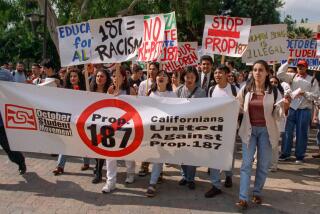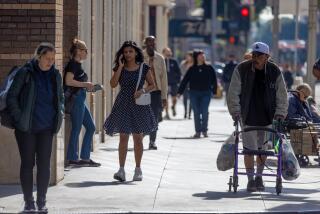Census Bureau counts on Stockton for testing
STOCKTON — U.S. officials kicked off plans Wednesday for a test run of the 2010 census in this San Joaquin Valley city, one of two places in the nation selected because its diverse immigrants, migrant laborers and suburban commuters reflect many of the challenges that make California notoriously difficult to count.
“They’re a microcosm of the country,” U.S. Commerce Undersecretary Cynthia A. Glassman said as she toured the area. “And they have pretty much all the challenges we’re facing elsewhere around the country.”
The stakes in an accurate count are enormous: State officials say undercounts have cost California a congressional seat and billions of federal dollars for social service programs based on population.
According to state estimates, the census undercounted California by about 500,000 people in 2000, and different methodologies in counting annual population growth have increased the discrepancies to about 1 million today, said Mary Heim, the chief of the state Finance Department’s demographic research unit.
The loss is costly. A 2001 study prepared for Congress by the PricewaterhouseCoopers accounting firm found that California risked losing $1.5 billion in federal funds for eight major programs, including $636 million for Los Angeles County.
In 1990, the state estimated that Californians were deprived of $2 billion in federal funding because of an undercount of 840,000 people.
Political power is also at stake. African Americans, Latinos, immigrants, migrant workers and the homeless tend to be disproportionately undercounted, researchers have found. Since they tend to vote Democratic, the issue has sparked more than two decades of partisan wrangling over who controls decisions about adjusting the census for undercounts.
Several ethnic groups have already begun mobilizing for greater inclusion. A coalition of Arab, Armenian, Iranian and other groups are lobbying to include a question about ancestry on the census short form, and Asian Americans want assurances that 2010 census materials will be available in major Asian languages.
Dan Ichinose of the Asian Pacific American Legal Center in Los Angeles said an undercount could jeopardize the right of non-English speakers to use foreign-language ballots in elections. Access to the ballots is based on the size of a community’s population.
Census officials said the 2010 poll questionnaire would be available in English, Spanish, Chinese, Korean, Japanese, Vietnamese and Tagalog. In addition, special assistance centers in local neighborhoods will offer translation guides in dozens of other languages.
On Wednesday, Glassman and other census officials officially opened the Stockton census office and previewed some of the prospects and pitfalls that enumerators will face in the trial run. It will take place next April, counting residents in a region where urban Stockton bumps up against farm fields, middle-class commuters roar past migrant field hands and 50 languages are spoken.
In the nearby town of French Camp, officials rolled past county jail facilities and other institutions. They visited a housing complex that shelters nearly 500 migrant farm laborers and their families, nearly all from Mexico, each season.
Cesar Garza, manager of the Joseph J. Artesi Migrant Center, said that word had already spread among the families about the trial run and that no one seemed fearful or resistant. But he said the counting task could prove harder in the outback camps.
“A lot of them live out in the fields, they live under drawbridges,” Garza said.
In southern Stockton, census officials toured areas with high crime, vacant storefronts and apartments in which three or four families live together.
To reach such communities, San Joaquin census officials expect to hire 2,000 local workers, aiming to select speakers of Spanish, Cambodian, Hmong and at least six other languages. Officials emphasized that census results would be confidential and that questions about immigration status would not be asked.
“It’s really about trust,” said Barbara Ferry, manager of the San Joaquin County census office. “We’ve got to elicit the help of the leaders people in these communities trust.”
Census officials also face challenges in suburbia -- a reality underscored by a visit south of Stockton to a new subdivision of sprawling tile-roofed tract houses in Lathrop, one of the fastest-growing communities in the West.
Standing in front of a vacant lot soon to sprout more houses, Vice Mayor Sonny Dhaliwal said the community was expected to grow from 15,000 residents to more than 100,000 in the next 25 years. Officials will need to stay abreast of every new address in the new developments, they said.
One reality in some suburbs, officials said, can prove vexing: gated communities. Although they keep out traffic and crime, the barriers can also impede access for enumerators.
To address those challenges, census officials see promise in new hand-held devices that each enumerator will carry. They store real-time information on each address with the aid of GPS, and then use encrypted databases to transmit the data.
Preston Jay Waite, the Census Bureau’s deputy director, said officials plan to begin a substantial publicity campaign to ensure a high response rate. The bureau relied only on free public service announcements in 1990. It spent about $200 million in paid advertising in 2000 and plans to mount a comparable effort for 2010, he said.
State, local and nonprofit agencies also expect to invest in a significant outreach campaign. In 2000, California spent $24.7 million to target public schools, homeless shelters, immigrant community centers, health clinics, movie theaters and other locales. Waite and others credited the effort with boosting California’s response rate to 70%, higher than the national average.
In Stockton, officials know the stakes all too well.
“We receive government funding that’s dependent on the government count,” said Jose Rodriguez, executive director of El Concilio, a nonprofit social services agency. That count, he said, “will have an impact on our lives for the next 10 years.”
eric.bailey@latimes.com
More to Read
Get the L.A. Times Politics newsletter
Deeply reported insights into legislation, politics and policy from Sacramento, Washington and beyond. In your inbox three times per week.
You may occasionally receive promotional content from the Los Angeles Times.











